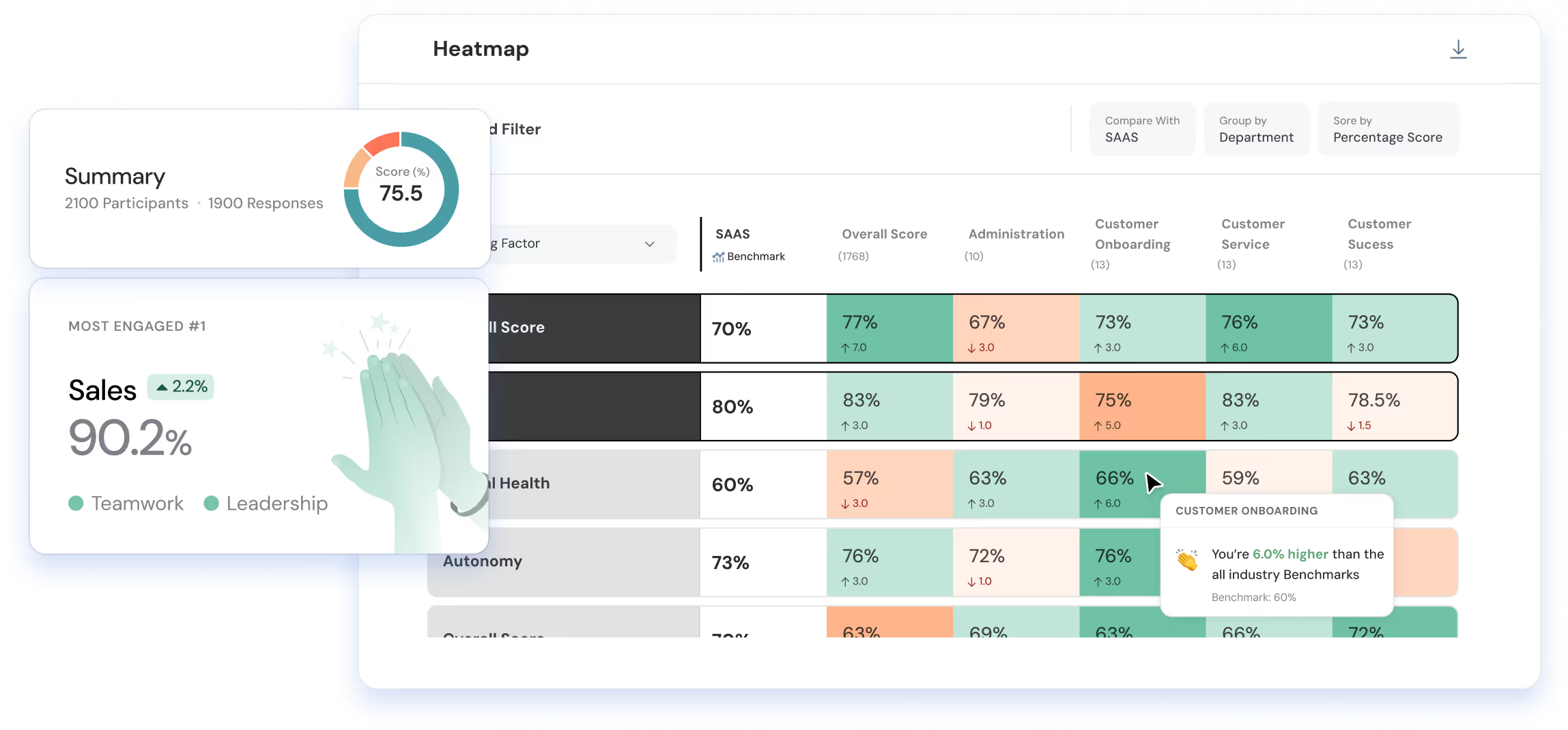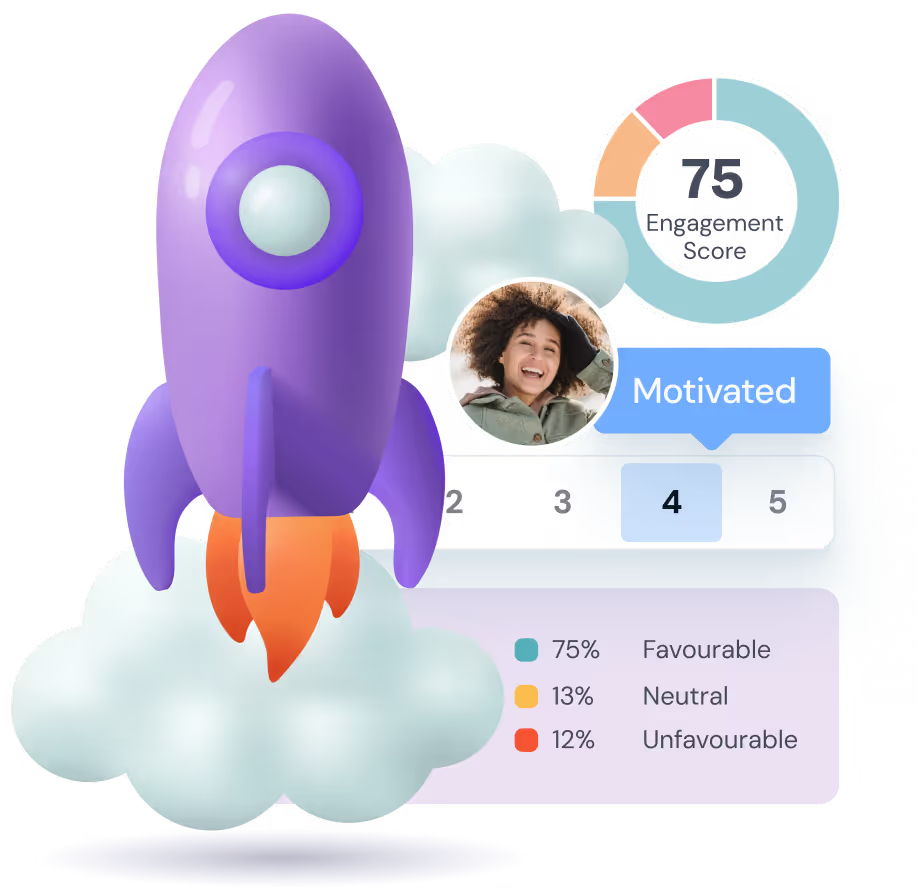The cost of disengagement is around $450-$550 billion each year! [Source: Haiilo]
That's expensive, even for the most profitable companies around. In order to re-engage these employees and keep them satisfied, we first need to analyze what drives this engagement.
Disengaged employees can be often identified by their lower levels of motivation and a low passion and drive to achieve the best outcomes at work; but re-engaging them is a whole other story.
So, let's understand what drives engagement. By the end of this article, you'll get a clear understanding of the various employee engagement drivers, along with some important tips to drive engagement.
What Is Employee Engagement?
Employee Engagement is defined as the level of commitment and dedication an employee shows towards their work. An engaged employee is someone passionate and purpose-driven and gives their all towards achieving the organization's goals.
The Drivers of Employee Engagement
Employee engagement drivers are the factors that shape how motivated, committed, and connected employees feel at work. They influence everything from daily performance to long-term retention.
Broadly speaking, employees fall into three levels of engagement:
- Actively engaged: highly motivated and emotionally invested in their work.
- Not engaged: doing what’s required, but without much enthusiasm.
- Disengaged: disconnected from their role, the team, or the organization.
Understanding what drives engagement helps organizations design better workplaces — ones that motivate employees, strengthen culture, and lower turnover.
Here are 12 key drivers of employee engagement that can guide your strategy and create a thriving, people-first culture:
- Recognition
- Career development opportunities
- Autonomy at work
- Purpose-driven work
- Work-life balance
- Supportive leadership
- Job security
- Team dynamics
- Company culture and values
- Wellness programs
- Innovation and creativity
- Employee voice
1. Recognition
Employees who are recognized are 63% more likely to stay at their current job. [Apollo Technical]
Furthermore, organizations with recognition experience 14% higher engagement, productivity, and performance than those without. [Deloitte]
Recognition is a big part of reinforcing a positive work culture within the organization. When employees are recognized for their achievements, their morale increases, along with their motivation to perform better at work.
Reinforce a positive work culture with ThriveSparrow. Create a workplace where appreciation and recognition thrive, and let everyone join in the celebration—all in one place.

2. Professional Development Opportunities
Employees value it when organizations offer and invest in employees' skills and career development.
55% of employees consider career growth and opportunities to be more important than their pay-grade while choosing their career. [Zippia]
When organizations invest in the growth of employees, it nurtures a sense of assuredness in them. And highly skilled and trained employees bring out the best performance that they can.
Getting access to training and development opportunities also boosts employee morale and keeps them engaged at work.
According to Zippia, 68% of employees prefer to learn and train on the job.
3. Autonomy
Employee autonomy can be simply defined as giving employees full control of their work.
It helps them feel a strong sense of ownership at work. Employees tend to perform better and approach their work with a positive mindset when they are given full autonomy at work.
Moreover, allowing employees to make their own decisions at work bridges a sense of trust between them and the employer. It essentially tells an employee that the organization trusts them enough to make their own decisions and deliver quality work.
4. A Sense of Purpose at Work
Having meaningful work makes employees feel motivated and driven every day.
When their objectives are aligned with the goals of the organization, there's simply no obstacle to their engagement levels. Employees want to be recognized for who they are and how they contribute towards a common goal. This induces a shared sense of purpose and boosts engagement.
The Global Leadership Forecast 2025, which surveyed over 11,000 leaders worldwide, found that when leadership strategies are rooted in purpose, organizations see up to a 17× increase in employee engagement.
Purpose acts as the connective tissue between leadership, communication, and organizational goals. When leaders clearly align strategy with a shared sense of purpose, employees feel more inspired, valued, and invested in their work.
The study also highlights that this alignment doesn’t just improve engagement — it also accelerates AI adoption and other large-scale organizational changes. In uncertain times, companies that prioritize purpose, trust, and transparent communication outperform those that focus solely on technology or processes.
5. Work-Life Balance
Work and personal time are two sides of the same coin. Promoting an equilibrium between the two is key to creating a positive work-life balance.
A 2023 report by Randstad found that 94% of employees prioritized work-life balance. Additionally, it revealed that 61% of people wouldn't accept a job if it disrupted their work-life balance.
A poor work-life balance can employee burnout and can demotivate them. This will also lead them to be more disengaged at work. This leads to employees being more happier and engaged at work.
8-hour work shifts, work-from-home options, ample vacation days, earned leaves, and a comfortable work environment are all good examples for an organization to implement. It can boost an employee's drive to show up to work daily and give it their all.
6. A Good Manager
Having a manager who just assigns tasks isn't enough.
Effective managers are those who mentor and guide, providing consistent guidance, recognition, and feedback. This approach fosters a collaborative and trusting atmosphere, significantly influencing team engagement.
In fact, a manager's style and approach can account for up to 70% of the variance in team engagement levels. Therefore, a manager who skillfully balances leadership with mentorship plays a crucial role in driving employee engagement and overall team success.
7. Job Security and Stability
Employees who feel secure in their roles are more likely to be engaged.
According to a study by Gallup, researchers found that engagement decreases by 37% among employees who feel insecure about their jobs.
When managers or supervisors offer their support and are open and approachable, it can ease employee stress and improve engagement.
Another key finding in the same study found that engagement increases by 13% for employees who have a supportive supervisor.
8. Team Dynamics
Healthy team relationships and a sense of belonging can drive engagement. Including how teamwork and collaboration contribute to a fulfilling work environment could enrich your blog.
More than 50% of employees rely on collaboration, and 75% of them rate teamwork and collaboration as important.
Therefore, these statistics underscore the link between teamwork and engagement, making it a key driver of employee engagement.
Read more: 9 real-life examples of effective team dynamics
9. Positive Company Culture
Aligning a company's culture with individual values can significantly enhance employee engagement. Following are some of the ways that you can implement this:
- Set the right tone with a smooth onboarding experience.
- Provide ongoing training and development
- Provide proper tools and resources
- Implement regular feedback and coaching
10. Workplace Wellness
There are many benefits to supporting and encouraging employee wellness at the workplace. With wellness programs, you can
- Improve employee health
- Increase productivity
- Reduces absenteeism and stress
According to Zippia, 80% of employees whose employers are engaged in their wellness say they enjoy work.
11. Innovation and Creativity
Opportunities for employees to be creative and innovative in their roles can increase engagement. To put it simply innovation drives engagement, and in turn, engaged employees contribute to innovation.
12. Employee Voice
Encouraging employees to express their thoughts and ideas is a vital aspect of employee engagement. Creating channels where employees can voice their opinions ensures they feel valued and heard.
Regular forums, suggestion boxes, town hall meeting, and other digital platforms for feedback are all ingenious ways of listening to employees.
Such a culture can lead to increased job satisfaction and a more engaged workforce.
The Dimensions of Employee Engagement
Kahn's theory gives you a proper understanding of the different dimensions of employee engagement.
Backed with the three dimensions of employee engagement, you can create actionable strategies that actually drive engagement.
Kahn's theory of employee engagement revolves around three key dimensions:
- Physical engagement
- Cognitive engagement
- Emotional engagement

Following his research on 'Psychological Conditions of Personal Engagement and Disengagement', Kahn defined the dimensions of employee engagement as follows;
Physical engagement
This dimension talks about the physical and mental efforts of employees as they go about their jobs. According to Kahn, increased feelings of confidence with high engagement at work.
Cognitive engagement
This dimension involves the understanding of the organization's vision and strategy. Kahn theorized that a profound understanding of the vision, and an attachment to one's work along with increased knowledge brought about more creativity and confident decision-making.
Emotional engagement
This dimension talks about emotionally engaged employees having positive feelings towards their job and channeling those feelings into their work. They're more likely to be more invested in their jobs and experience greater job satisfaction.
However, a lot of time has passed and Kahn's theory may not be relevant in 2024, as there was further research conducted on this. This is just a basic breakdown of the various dimensions of employee engagement.
10 Tips to Boost Employee Engagement
Apart from paying them well, which is a no-brainer, here are some tips that you can implement and apply to ensure maximum effectiveness of your employee engagement initiatives.
1. Collect Regular Feedback and Act On It
Utilize employee surveys regularly to collect employee feedback anonymously and act on the feedback. Collecting feedback on a regular basis allows you to stay on top of any concerns that employees might have, and equips you with preventing any issues before they arise.
One-on-one meetings and focus groups are other excellent means by which you can collect feedback. However, surveys are the best method for collecting feedback anonymously. Ensuring anonymity with surveys reassures employees to provide honest and transparent feedback.

2. Show Transparency
Make employees feel heard and valued during the decision-making process.
In instances where employees aren't a part of the decision-making process, keep them in the loop and communicate the reason and purpose of new decisions made. This is the kind of transparency that employees need, which helps build trust and a shared sense of purpose among them.
3. Offer Regular Support to Your Employees
Employees feel valued and motivated when managers offer regular support and frequently check in on them. Being a mentor and showing support to their teams are all good qualities that every manager has.
This not only fosters a culture of trust and respect but also increases engagement. Employees who receive regular support and guidance from their manager will want to show up to work regularly and will perform at their best.
4. Appreciate and Recognize Where It Matters
A simple appreciation of an achievement, big or small, can boost an employee's morale. It also reinforces a sense of accomplishment and motivates them to pursue further achievements.
Consistently appreciating and applauding their efforts, develops a sense of loyalty and attachment to the company.
It doesn't matter if it is a simple thank-you or a pat on the back; whether it is a monetary or a non-monetary reward, a simple and thoughtful one, can appear as generous. You can also add some fun awards to the mix to stir things up and bring more smiles to the workplace.
It isn't just about saying 'good job', but also about making them feel seen and appreciated.
5. Promote an Inclusive Space
Allowing employees to share their thoughts and concerns freely and openly can help employees feel like a part of the team and not feel secluded. Promoting such an environment where employees can comfortably communicate their thoughts and concerns, can enhance their engagement levels.
Ideally, everyone should feel comfortable expressing themselves.
6. Provide Opportunities for Growth and Promotions
Offer mentorship and training opportunities to employees who want to upskill themselves and contribute more to the organization. Use one-on-ones and feedback surveys to come up with individual development plans. Additionally, identify the top performers in your organization and look for opportunities to help them grow. This can be in the form of them undertaking more challenging projects or giving them a promotion.
7. Implement Fun and Engaging Activities
Plan to include games and activities on a weekly or monthly basis to help employees relax for some time at work. You can start a 'fun Friday' theme at the office where employees can participate in fun activities for an hour or two. This is a great way for employees to relieve work stress and have a little bit of fun.
Dress-up Fridays, quizzes, and afternoon trivia are other excellent ways to engage employees.
Whether your employees are working remotely, or at the office, there's always something for everyone. For example, GitLab, which has one of the largest remote workforces in the world, encourages their employees to get on virtual calls with others occasionally and talk - called 'Virtual coffee breaks.'
8. Give the Right Tools and Workspace Setting
Ensure your employees have all the right tools with them to remain productive and efficient.
For example, project management tools like Jira and Trello, give your employees the roadmap to collaborate effortlessly and complete tasks on time.
A comfortable workspace and atmosphere contribute to an employee's engagement as well. Proper lighting conditions, clean ventilation, AC, and a comfortable chair are some of the important parameters that make up a good workspace.
9. Show that You Care - An underrated one 🙂
As an organization, showing that you care about your employee's well-being and happiness apart from just the bottom line will elevate your company's face as a good place to work.
It can increase your company's reputation as a socially responsible company, something that is valued by the vast majority of millennials.
If you do this right, you'll be the most preferred employer among many others who follow suit.
10. Understand Engagement Better
By using engagement survey platforms, you can obtain valuable insights into your employees' engagement levels, and the feedback from the surveys can be used to guide your engagement efforts in the right direction.
For example, ThriveSparrow offers a range of comprehensive surveys to help you monitor your employees' engagement, and generates detailed reports that provide a clear picture of your team's pulse.
Moreover, the platform's heatmaps give a clear overview of engagement levels across departments.

In addition to that, you can understand what factors correlate with high engagement and what doesn't.
Backed by this data, build targeted plans to address specific areas for improvement.

Try ThriveSparrow today, conduct regular engagement surveys with just a few clicks, and drive your engagement efforts seamlessly throughout your organization.
Become the HR everybody loves. Start engaging your people today. Try for free now.
Refine and Uplift Your Employees' Engagement
Organizations must keep a note of all these drivers of engagement and utilize the tips to enhance engagement. Having a sense of purpose at work, and obtaining regular feedback, recognition, and autonomy are some of the main drivers of engagement.
There are many ways to collect feedback and refine the employee experience. However, the best way to do so is with surveys, and a survey platform is best at collecting feedback and organizing it into reports, giving managers and top executives key insights into employee engagement.
Learn more about ThriveSparrow's employee engagement solution and use the data generated to visualize and guide your engagement efforts.

















